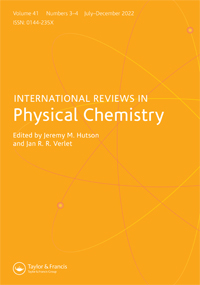Nature and strength of sulfur-centred hydrogen bonds: laser spectroscopic investigations in the gas phase and quantum-chemical calculations
IF 2.5
2区 化学
Q3 CHEMISTRY, PHYSICAL
引用次数: 46
Abstract
The importance of Sulfur centred hydrogen bonds (SCHBs) cannot be underestimated given the current day knowledge of its non-covalent interactions prevalent in many biopolymers as well as in organic systems. Based on the distance/angle constraints available from the structural database, these interactions have been interchangeably termed as van der Waals/hydrogen bonded complexes. There is a lack of sufficient spectroscopic evidence that can unequivocally term these interactions as hydrogen bonding interactions. In this review we present laser spectroscopic investigations of isolated binary complexes of H-bond donor-acceptor molecules containing Sulfur atom. The complexes were formed using supersonic jet expansion method and the IR/UV spectroscopic investigations were carried out on mass selected binary complexes. The pertinent questions regarding SCHBs addressed herein are (1) Is electronegativity the controlling factor to be a potent H-bond donor/acceptor? (2) How do SCHBs compare with their oxygen counterpart? (3) What is the nature of SCHBs, i.e. what are the dominating forces in stabilising these hydrogen bonds? (4) Do SCHBs follow classical H-bond acid–base formalism? (5) Are SCHBs found in peptides and proteins? If so, what are their strengths? Do they control the structure of the peptides? The experimental investigations were also supported by high level of ab initio computations.硫中心氢键的性质和强度:气相激光光谱研究和量子化学计算
硫中心氢键(schb)的重要性不能低估,因为目前的知识,它的非共价相互作用普遍存在于许多生物聚合物以及有机系统中。基于结构数据库中可用的距离/角度限制,这些相互作用可互换地称为范德华/氢键配合物。缺乏足够的光谱证据可以明确地将这些相互作用称为氢键相互作用。本文综述了含硫氢键给受体分子二元配合物的激光光谱研究。采用超音速射流膨胀法制备了配合物,并对质量选择的二元配合物进行了红外/紫外光谱研究。关于schb的相关问题有:(1)电负性是否是成为一个强有力的氢键供体/受体的控制因素?(2) schb与氧的对应物如何比较?(3) schb的性质是什么,即稳定这些氢键的主导力是什么?(4) schb是否遵循经典的氢键酸碱形式?(5) schb是否存在于多肽和蛋白质中?如果有,他们的优势是什么?它们控制肽的结构吗?实验研究也得到了高水平从头计算的支持。
本文章由计算机程序翻译,如有差异,请以英文原文为准。
求助全文
约1分钟内获得全文
求助全文
来源期刊
CiteScore
14.20
自引率
1.60%
发文量
5
审稿时长
1 months
期刊介绍:
International Reviews in Physical Chemistry publishes review articles describing frontier research areas in physical chemistry. Internationally renowned scientists describe their own research in the wider context of the field. The articles are of interest not only to specialists but also to those wishing to read general and authoritative accounts of recent developments in physical chemistry, chemical physics and theoretical chemistry. The journal appeals to research workers, lecturers and research students alike.

 求助内容:
求助内容: 应助结果提醒方式:
应助结果提醒方式:


